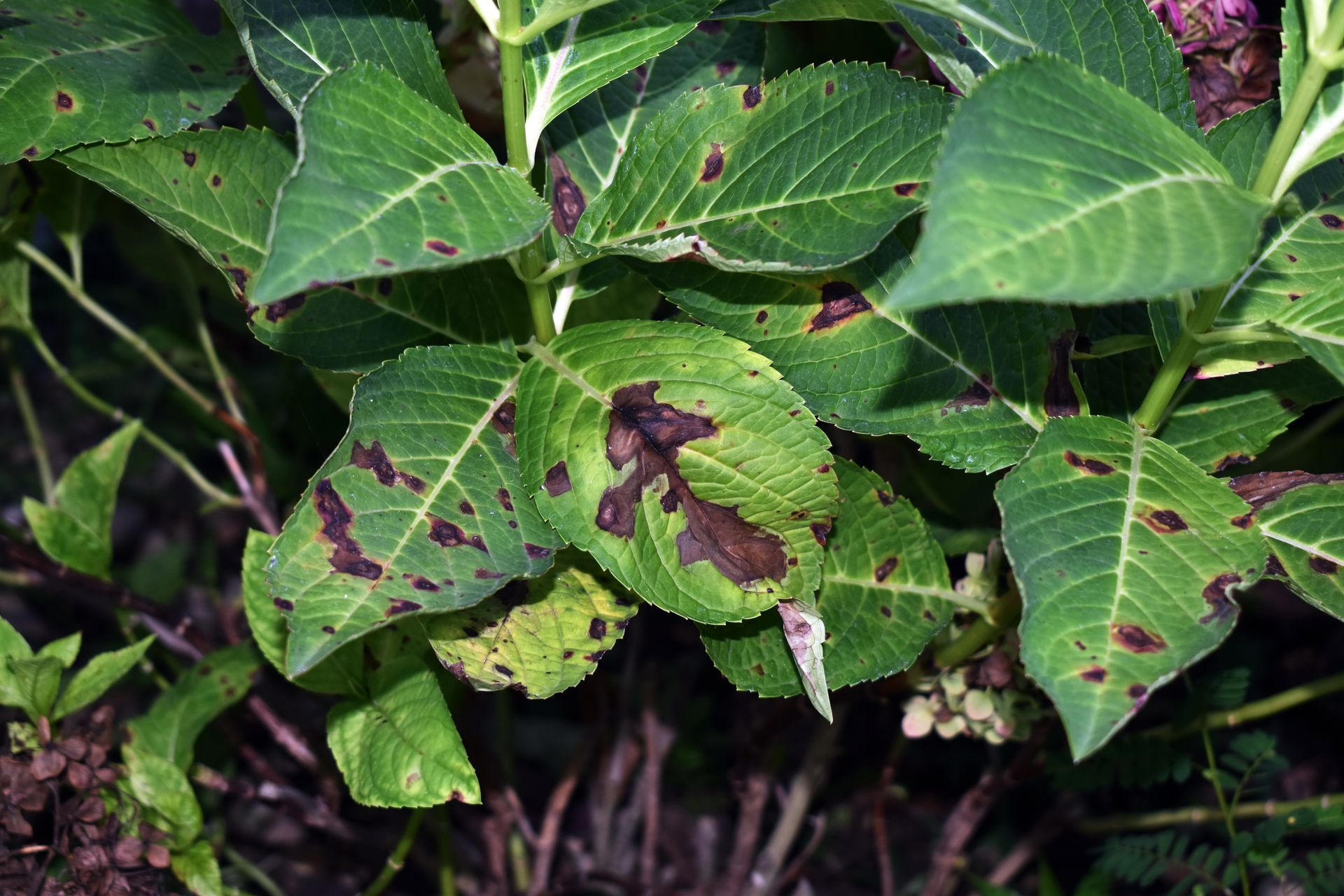Anthracnose Disease And Treatment

Anthracnose is a broad term for a group of fungal diseases in plants. The disease-causing fungi belong to the genus Colletotrichum. They cause several diseases, such as blossom blight and pepper spot disease.
Knowing about anthracnose diseases and treatment is essential to give your plants timely care. Keep reading to learn more about anthracnose tree disease, its symptoms, and treatment methods.
Table of Contents
What Is Anthracnose Disease?
Anthracnose disease is a fungal disease of various plants, including trees. Fungi from the Colletotrichum genus are responsible for these fungal diseases in plants, especially shade trees.
Many other fungal species can also cause anthracnose disease. The most common ones are Apiognomonia errabunda, Discula destructive, and Stegophora ulmea.
Infected plants develop water-soaked dark lesions on the fruit, leaves, and stem. Often, the center of these lesions is covered with a pink mass of spores. The mass is gelatinous during moist and warm weather.
Did You Know? Colletotrichum, the causative agent of the fungal disease anthracnose, produces spores in a fruiting body called acervulus. It is a tiny body with a saucer-like appearance. The acervuli form under the host tissue's epidermis. They contain conidiophores that form conidia or spores.
Besides lesions, anthracnose disease also leads to canker formation on infected twigs and stems. The disease mainly starts on the twigs and leaves. From there, it spreads to the shoots and leaves. That's why the condition is also called twig blight.
In early spring, these fungi produce microscopic spores. They spread through irrigation or splashing rain to new growth in shade trees.
When the spores fall on new areas, they germinate and enter new twigs. If the conditions remain moist, more spores are produced from the infected twigs.

The spores are produced throughout the year on some evergreen species, such as live oak and Chinese elm. But on deciduous trees, spore formation slows during dry and hot weather.
Many forms of anthracnose disease have been identified in the past few decades. A recent one is dogwood anthracnose. It was identified in the 1970s in North America.
Like other forms of the disease, dogwood anthracnose thrives in cool, wet spring weather. It affects dogwood trees in mountainous regions, resulting in the loss of natural strands. Its causative agent is Discula destructive.
Symptoms
The symptoms of anthracnose in trees vary across weather conditions and plant hosts. When shade trees get infected, the first sign is the appearance of leaf spots.
These spots may be brown, black, or beige. They appear on young twigs and leaves. The leaf spots are most common in sycamore, oak, and elm hosts.
Dead areas also develop in roots in some hosts. These include willow, maple, and ask. Anthracnose lesions also extend along the leaf veins in trees.
If young leaves are infected, they become distorted or curled. But only a small portion of each leaf dies in the process.
Anthracnose on trees defoliates the plant from the ground up. It leaves the leaves on the top of the tree undamaged. Meanwhile, the leaves on the lower part of the tree turn yellow and drop off.
Mature leaves resist anthracnose disease. But they may develop spotty lesions in conditions favorable for the fungus. When heavily infected, these leaves fall throughout the tree's growing season.
In severe anthracnose disease, especially in ash cultivars and Chinese elm, the fungi kill the branches and twigs. Cankers also develop, causing girdling.
In plants, girdling means blocking off the nutrient and water supply. Without proper nutrition, the plant's vigor decreases rapidly.
Affected Trees
The following trees are affected by tree disease anthracnose:
- Ash trees (Fraxinus spp.)
- Maple trees (Acer spp.)
- Oak trees (Quercus spp.)
- Sycamore trees (Platanus spp.)
- Dogwood trees (Cornus spp.)
- Elm trees (Ulmus spp.)
- Hickory trees (Carya spp.)
- London planetree (Platanus × acerifolia)
- Walnut trees (Juglans spp.)
- Cherry trees (Prunus spp.)
Resistant Trees
Although no tree is fully resistant to anthracnose disease, some species are relatively tolerant or resistant.
- Red oak (Q. rubra)
- Blue ash (Fraxinus quadrangulata)
- Pumpkin (F. tomentosa)
- Japanese walnut (J. ailanthifolia)
- Rock elm (Ulmus thomasii)
- Heartnut (J. ailanthifolia var. cordiformis)
- American ash (F. americana)
While these trees may be less susceptible to anthracnose, they may still be affected in some conditions. Some varieties in the same tree species are more resistant to anthracnose than others. Do your research before selecting the most resistant type.
How To Treat or Manage Anthracnose Disease on Trees
- Both treatment and management are essential for treating shade trees anthracnose. Here's how to treat anthracnose disease through natural and chemical methods.
Cultural Prevention Methods
Prune infected leaves and bury them during the winter or fall season. Do the same with twigs, branches, and leaves. However, do not prune branches of large diameter since this could trigger bushy water sprouts.
Prune smaller branches during winter. It will help increase air circulation and remove the dead or diseased branches from the previous season.
If a tree is severely infected, fertilize it after the leaf opening. It's best to fertilize after the rains stop in spring. Do not use irrigation systems that wet the plant leaves excessively.
Another way to control anthracnose is to pollard sycamores. Pollarding refers to cutting off the top of a tree to promote lateral branching. It removes all growth from the previous year to prevent the disease from manifesting in the new growing season.
Pollarding isn't the best approach for most trees. But it can help prevent anthracnose diseases in London plane trees.
Do note that pollarding makes the trees more susceptible to powdery mildew. If you want to plant a London plane, opt for the Yarwood cultivar since it resists powdery mildew.
Natural Methods
You can use a few natural fungicides to combat anthracnose plant disease and prevent tree death:
- Apply sulfur powder to leaf margins every week. Start application in early spring when the foliage begins developing.
- Spray a copper spray onto the infected leaves and twigs throughout the growing season. Make sure to spray early in the day. Do not spray in hot weather.
- Use neem oil spray on heavily infected leaves to prevent symptoms like premature leaf drop in oak and ash anthracnose. Apply the spray when spring budding begins. Weekly applications are the most efficient.
- Use a bio-fungicide, such as Bacillus subtilis in oak anthracnose. These fungicides are non-toxic to insects, such as bees, needed for pollination. Apply the bio-fungicide when new growth appears.
Plant Resistant Varieties
Planting resistant varieties is the best way to keep twig and leaf blight at bay. Suppose you want to plant dogwood.
Chinese dogwood and many cultivars of Pacific dogwood are highly susceptible to anthracnose. Instead, you should plant the following varieties:
- Bunchberry (C. canadensis)
- Carnelian cherry (C. mas)
- Chinese dogwood (C. kousa)
- Dogwood hybrids (C. kousa x C. florida): some cultivars
- Japanese cornel (C. officinialis)
Maple anthracnose is also common, especially in the Japanese maple tree and its cultivars. You can prevent maple anthracnose by planting:
- Evergreen maple (Acer paxii)
- Bigleaf maple (A. macrophyllum)
- Silver maple (A. saccharinum)
Similarly, if you want to avoid sycamore anthracnose, plant these cultivars of the London plane tree:
- Bloodgood
- Columbia
- Liberty
- Other varieties, such as American sycamore and California sycamore, are susceptible to sycamore anthracnose.
Fungicides
While natural management and treatment methods work wonders, chemical treatment is inevitable in some cases. There are many anthracnose fungicides, some more effective in specific tree species.
Fungicides do not eliminate the infection. But they protect the healthy tissues from disease. Apply pesticides and fungicides before cool, wet weather begins.
If moist weather prevails, apply the fungicides every two weeks. Here are some fungicides that work on most tree species.
- Chlorothalonil: Use fungicides, such as Daconil, that contain chlorothalonil. The chemical is non-systemic and broad spectrum. Its exact mechanism of action is unknown. But it has multiple roles, such as being a microbicide, bactericide, insecticide, and algaecide.
- Copper Diammonia Diacetate: Most copper-based fungicides, like Liquicop, contain copper diammonia diacetate. Copper fungicides work by killing proteins and enzymes in fungi. So they keep fungus from spreading any further.
- Propiconazole: Banner Maxx II is a propiconazole-based fungicide. Propiconazole is a systemic product absorbed into the plant, stopping and preventing further fungal growth.
- Thiophanate-methyl: An example of this fungicide is Cleary's 3336. It fights diseases that affect ground covers, bedding plants, and foliage plants. Do not use thiophanate-methyl fungicides without professional assistance.
Sweet New Earth's Final Word
Thanks for stopping by! Tree diseases are an annoying part of raising trees that we as gardeners need to get past in order to raise them to be healthy and beautiful trees.
FAQs

Christina Hernandez
Christina has done most of her research on environmental science but recently has changed her focus towards sustainable forestry. She has a passion for the outdoors and wants to spread that passion to the world.
Join our community!
Join to receive guides, insights, and the latest gardening deals!
